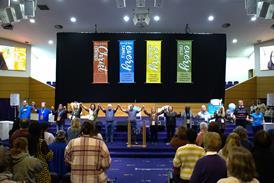
Let me give you two pictures of youth work from the world of architecture. The first is this; youth work as a buttress. A buttress is something that is built up around a structure to support it and hold it in place. You have a buttress when a building won’t stay up on its own. If some internal or external force is going to cause the building to collapse, you shove a buttress on the side to hold the wall in place. This is a lot of youth work in the country. We want young people to stay involved in church but there are lots of forces pulling them out of it. So we provide buttressing structures and activities to hold them in place. A 12 year old is bored in church and wants to leave? Run a group during the boring parts of a church service that’s exciting! A 16 year old wants to go out with the friends drinking on a Friday night? Run an entertaining youth evening so they have something else to do! These buttressing events at least temporarily overcome the forces pulling young people out of church. Paying your young people to come to church is highly unusual but a natural outworking of this way of thinking about ministry. It’s a super-effective way of keeping young people in church against other forces that might pull them out.
The problem with the buttressing approach is that it doesn’t work for very long. Almost inevitably for a young person in this day and age, the forces pushing to leave church will overcome any forces you can put up to keep a young person in church. If a young person finds church boring, and you provide activities to make it more exciting, what happens when they discover something even more exciting elsewhere? Can you really promise to be always more exciting than the way the world does things? Are you going to be able to out-excite going out and getting drunk? Or playing football on a Sunday morning? Maybe you can buttress them in long-enough that they get to university or even into work without leaving church, but then what will keep them there? The explosion of organisations working with 18-30 year olds in the last decade seems to indicate we’re trying to replicate the same approach with that age range.
So what about another way of looking at youth ministry? Instead of a buttress, youth ministry is scaffolding. Scaffolding doesn’t hold a building up. Instead it’s a temporary structure that exists while something is being built. It exists to allow work to be done to strengthen and repair the building and then it’s taken down again. A youth minister does ministry so that the young people are built up, strengthened, come to know Jesus and consequentially stay in the church. The difference in this approach is that you’re seeking true heart change. You don’t want to hold young people in church when there heart is not there. You want the young people to come to church because they see it as the family they’ve been called into when they were saved. This approach seeks the true conversion of young people and them growing in Christ so they can securely be part of the church. They don’t need any externally designed buttress to overcome the forces pulling them out of the church; the internal force of the Holy Spirit transforming their hearts means they want to stay in it themselves and be part of it.
Practically, what difference does it make? It won’t be so much in what you do, but in why you do it and therefore how you do it. If you think youth work is like a buttress then you’re always going to be thinking ‘how can we keep these kids in church’, and you’re going to end up burdened with more responsibility than you can carry as you bear the weight of ensuring these kids don’t leave church. Your youth sessions will always have a sense of ‘if only there were more people here, if only I could make them more committed to coming to things’.
If you think youth work is like scaffolding though you’ll be thinking ‘how can I encourage young people to trust in Jesus more, how can I build them up in him?’ You’ll be looking for heart change in the young people and them to come to trust in Jesus for themselves. Your youth sessions will have a sense of ‘is this helping the young people I have to know more about Jesus and his gospel? Is this helping young people who don’t know Jesus come to know him?’ In one sense this is much harder; you can’t open someone eyes to see Jesus’ glory, only he can. You can’t change a young person’s heart to rely more on Jesus’ work, only he can. You see how powerless you are. But in another sense it’s much easier, because all the power and weight of responsibility rests on Jesus’ strength and not your own. In the architecture metaphor, he’s the foundation stone that the young people are building on. Strong, and never to fall down. You don’t need a buttress if you’re built on him.
Mark Walley is a youth worker. He tweets @Sparticus, he blogs at thegroveisonfire.com, and has a real, actual child.






































